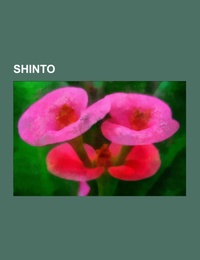-
Zusatztext
-
Source: Wikipedia. Pages: 134. Chapters: Tenrikyo, Veneration of the dead, Japanese festivals, Tanabata, Shinto music, List of National Treasures of Japan, Shinto shrine, Torii, Shinbutsu shugo, Shinto sects and schools, Shinbutsu bunri, Glossary of Shinto, Nihon Shoki, Izumo-taisha, List of significant religious sites, Toro, Miko, Sanja Matsuri, Hadaka Matsuri, Shinto in popular culture, Shinbutsu kakuri, Tamagushi, Yorishiro, Koshinto, Kamakura's festivals and events, Haibutsu kishaku, Kojiki, State Shinto, Kagura, Gongen, Shintoshu, Gion Matsuri, Izumo no Okuni, Ishidori Matsuri, Sakaki, Koshin, Kotodama, Konkokyo, Yoshida Kanetomo, Taisha-zukuri, Mitama, Boshita Festival, Tamagaki, Kanjo, Kumano Kodo, Shintai, Setsumatsusha, Sumiyoshi-zukuri, Kannushi, Omikuji, Misogi, Ujigami, Honden, Kagami mochi, Shinmei-zukuri, Hachiman-zukuri, Nagare-zukuri, Kegare, Kasuga-zukuri, Shinto in Taiwan, Honen Matsuri, Omamori, Yasaka Koshin-do, Kanamara Matsuri, Kasama Inari Shrine, Ishi-no-ma-zukuri, Konjin, Association of Shinto Shrines, Hatsumode, Tsumi, Onogoro Island, Kanda Matsuri, Himorogi, Gohei, Kurozumikyo, Jindai moji, Takamagahara, Hiyoshi-zukuri, Kamidana, Mikoshi, Sando, Shimenawa, Arahitogami, Hokora, Shide, Haiden, Ema, Ofuda, Chozuya, Tado Festival, Miyamairi, Three Palace Sanctuaries, Suzu, Utagaki, New Sect Shintoists, Mitake-kyo, Heiden, Ashihara no Nakatsukuni, Kagura-den, Harae, Hama Yumi, Onusa, The Lotus and the Robot, Soku-no-Kumi, Izumo-taishakyo, Sato kagura, Shrine Shintoists, Shinto Honkyoku, Kanai Anzen, Reikon, Azusayumi, Bunrei. Excerpt: Connection Timeout Shinto Shinto) or kami-no-michi is the indigenous spirituality of Japan and the Japanese people. It is a set of practices, to be carried out diligently, to establish a connection between present day Japan and its ancient past. Shinto practices were first recorded and codified in the written historical records of the Kojiki and Nihon Shoki in the 7th and 8th century. Still, these earliest Japanese writings do not refer to a unified "Shinto religion", but rather to disorganized folklore, history, and mythology. Shinto today is a term that applies to public shrines suited to various purposes such as war memorials, harvest festivals, romance, and historical monuments, as well as various sectarian organizations. Practitioners express their diverse beliefs through a standard language and practice, adopting a similar style in dress and ritual, dating from around the time of the Nara and Heian Periods. The word Shinto ("Way of the Gods") was adopted from the written Chinese (, shén dào), combining two kanji: "shin" ), meaning kami; and "to" ), or "do" meaning a philosophical path or study (originally from the Chinese word tao). Kami are defined in English as "spirits", "essences" or "deities", that are associated with many understood formats; in some cases being human-like, in others being animistic, and others being associated with more abstract "natural" forces in the world (mountains, rivers, lightning, wind, waves, trees, rocks). Kami and people are not separate; they exist within the same world and share its interrelated complexity. There are currently 119 million official practitioners of Shinto in Japan, although a person who practices any manner of Shinto rituals may be so counted. The vast majority of Japanese people who take part in Shinto rituals also practice Buddhist ancestor worship. However, unlike many monotheistic religious practices, Shinto and Buddhism.
-
Detailansicht
Shinto
Tenrikyo, Veneration of the dead, Japanese festivals, Tanabata, Shinto music, List of National Treasures of Japan, Shinto shrine, Torii, Shinbutsu shugo, Shinto sects and schools, Shinbutsu bunri, Glossary of Shinto, Nihon Shoki
ISBN/EAN: 9781156603376
Umbreit-Nr.: 5567702
Sprache:
Englisch
Umfang: 134 S.
Format in cm: 0.8 x 24.6 x 18.9
Einband:
kartoniertes Buch
Erschienen am 21.08.2013
Auflage: 1/2013


